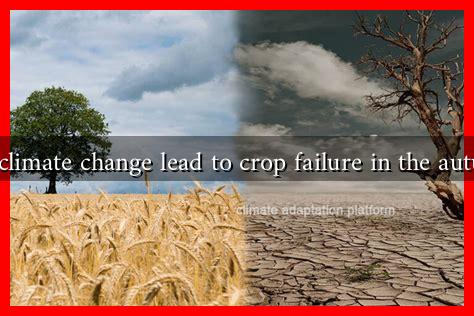-
Table of Contents
Can Climate Change Lead to Crop Failure in the Autumn?
Climate change is one of the most pressing issues of our time, affecting various aspects of life, including agriculture. As global temperatures rise and weather patterns shift, the implications for crop production become increasingly concerning. This article explores how climate change can lead to crop failure in the autumn, examining the mechanisms behind this phenomenon, its impacts, and potential solutions.
The Mechanisms of Climate Change Affecting Agriculture
Climate change influences agriculture through several interconnected mechanisms:
- Temperature Increases: Higher temperatures can accelerate plant growth but may also lead to heat stress, particularly during critical growth stages.
- Altered Precipitation Patterns: Changes in rainfall can result in droughts or floods, both of which can devastate crops.
- Increased Pest and Disease Pressure: Warmer temperatures can expand the range and lifecycle of pests and diseases, threatening crop yields.
- Soil Degradation: Extreme weather events can lead to soil erosion and nutrient depletion, further compromising crop health.
Case Studies: Crop Failures Linked to Climate Change
Several case studies illustrate the direct impact of climate change on autumn crop failures:
- California Droughts: In recent years, California has experienced severe droughts, leading to significant reductions in yields for crops like almonds and tomatoes. The 2014 drought alone resulted in an estimated $2.2 billion loss in agricultural revenue.
- European Heatwaves: The summer of 2019 saw unprecedented heatwaves across Europe, which led to a 30% reduction in wheat yields in some regions. Farmers reported that the extreme heat caused crops to mature too quickly, resulting in lower quality and quantity.
- East African Locust Infestation: In 2020, East Africa faced a locust invasion exacerbated by climate change. The warm, wet conditions allowed locust populations to explode, devastating crops in countries like Kenya and Ethiopia, where many rely on agriculture for their livelihoods.
Statistics Highlighting the Impact of Climate Change on Crop Yields
Statistics provide a stark reminder of the potential for crop failure due to climate change:
- According to the Intergovernmental Panel on Climate Change (IPCC), global crop yields could decline by up to 25% by 2050 if current trends continue.
- The Food and Agriculture Organization (FAO) estimates that climate change could push an additional 100 million people into hunger by 2030.
- A study published in the journal Nature found that for every 1°C increase in temperature, wheat yields could decrease by 6% and rice yields by 10%.
Potential Solutions to Mitigate Crop Failures
While the challenges posed by climate change are significant, there are several strategies that can help mitigate the risk of crop failures:
- Adopting Climate-Resilient Crops: Developing and planting crop varieties that are more tolerant to heat, drought, and pests can help maintain yields.
- Improving Water Management: Implementing efficient irrigation systems and rainwater harvesting can help farmers cope with changing precipitation patterns.
- Soil Health Practices: Techniques such as cover cropping, crop rotation, and reduced tillage can enhance soil health and resilience.
- Policy and Support: Governments and organizations can provide financial support and resources to help farmers adapt to changing conditions.
Conclusion
Climate change poses a significant threat to global agriculture, particularly in the autumn when many crops are harvested. The mechanisms of climate change, including rising temperatures, altered precipitation patterns, and increased pest pressures, can lead to devastating crop failures. Case studies from around the world highlight the urgent need for action, as statistics indicate that without intervention, millions could face food insecurity in the coming decades.
However, by adopting innovative agricultural practices and supporting farmers in their adaptation efforts, we can mitigate the impacts of climate change on crop production. The future of food security depends on our ability to respond effectively to these challenges.
For more information on climate change and its impact on agriculture, visit the Intergovernmental Panel on Climate Change.

